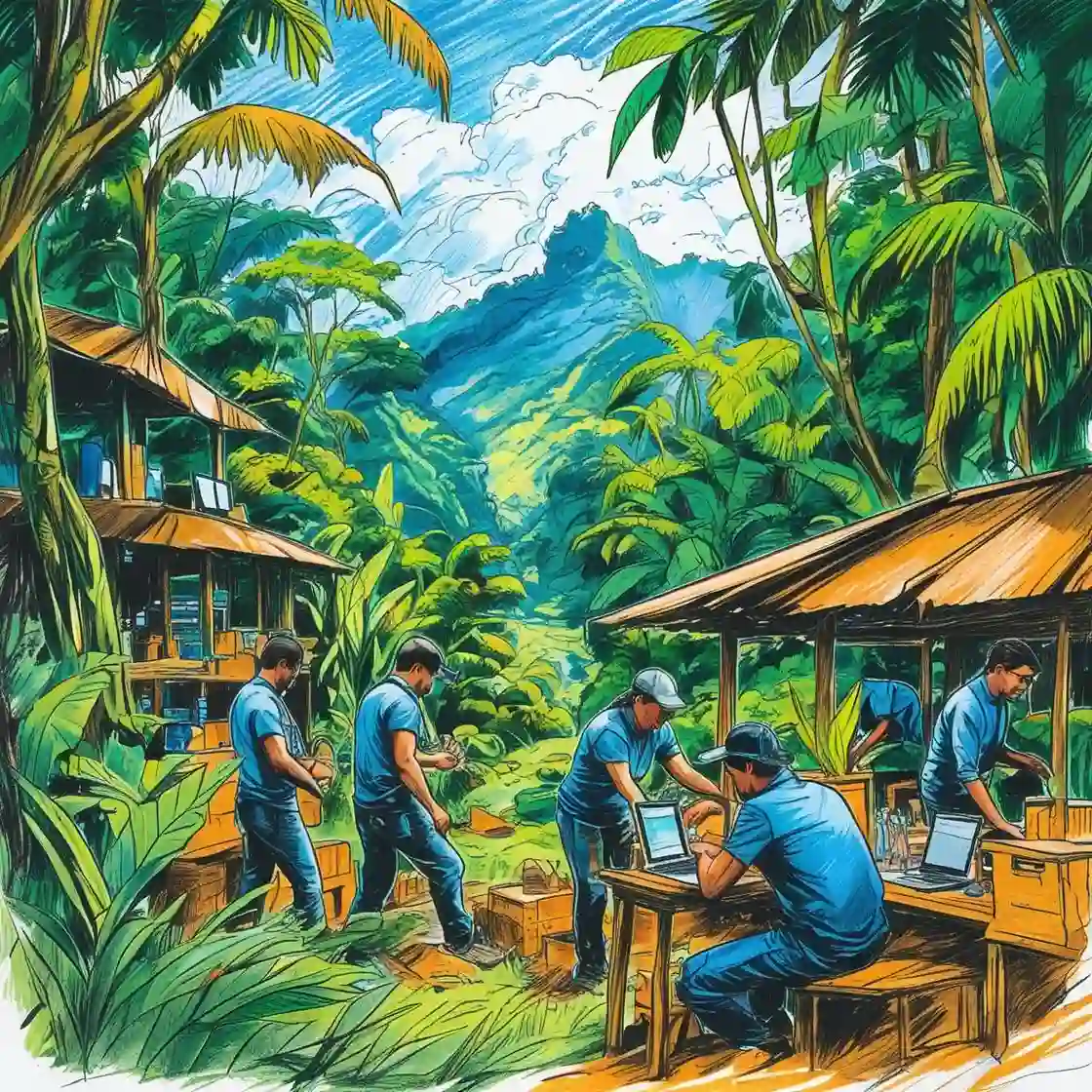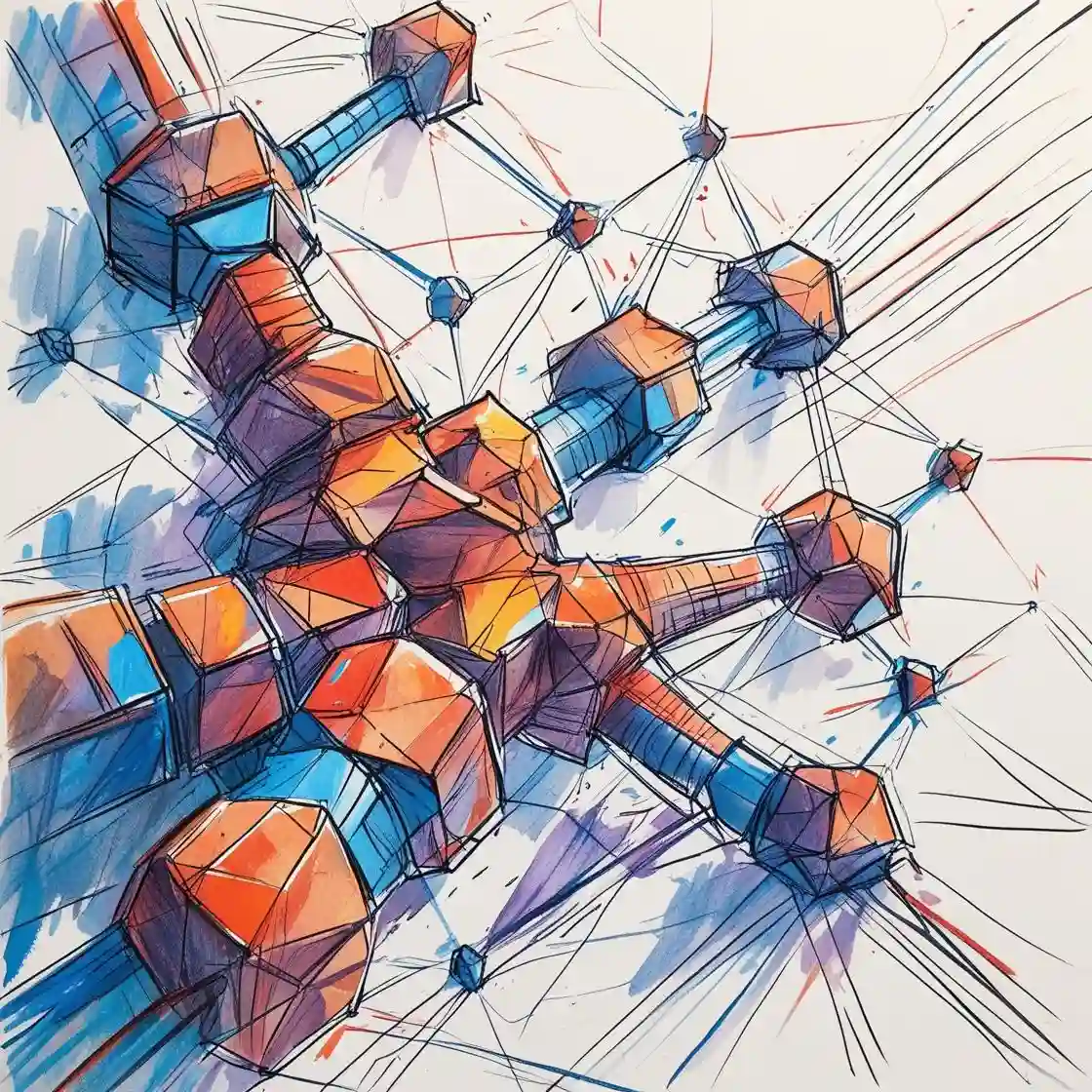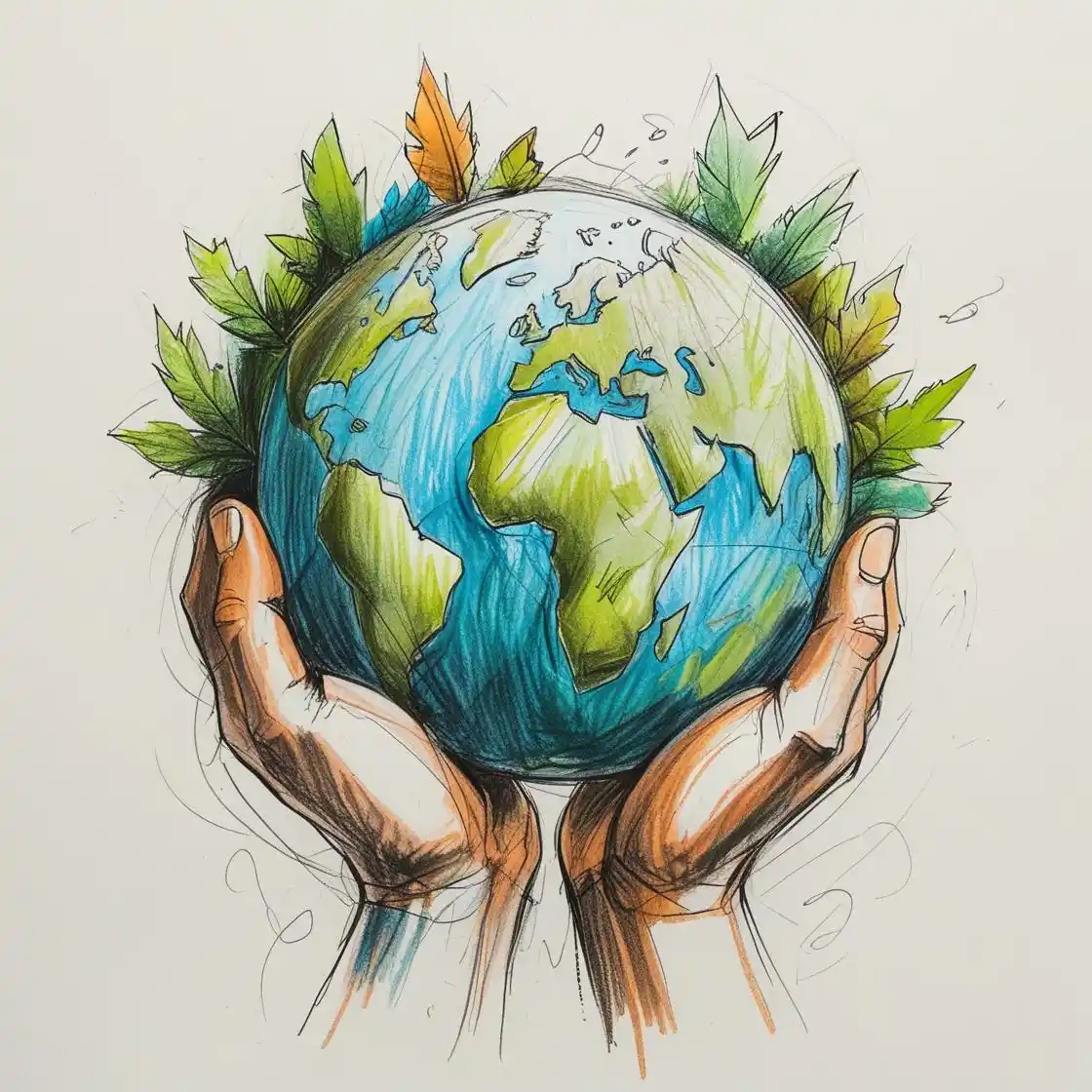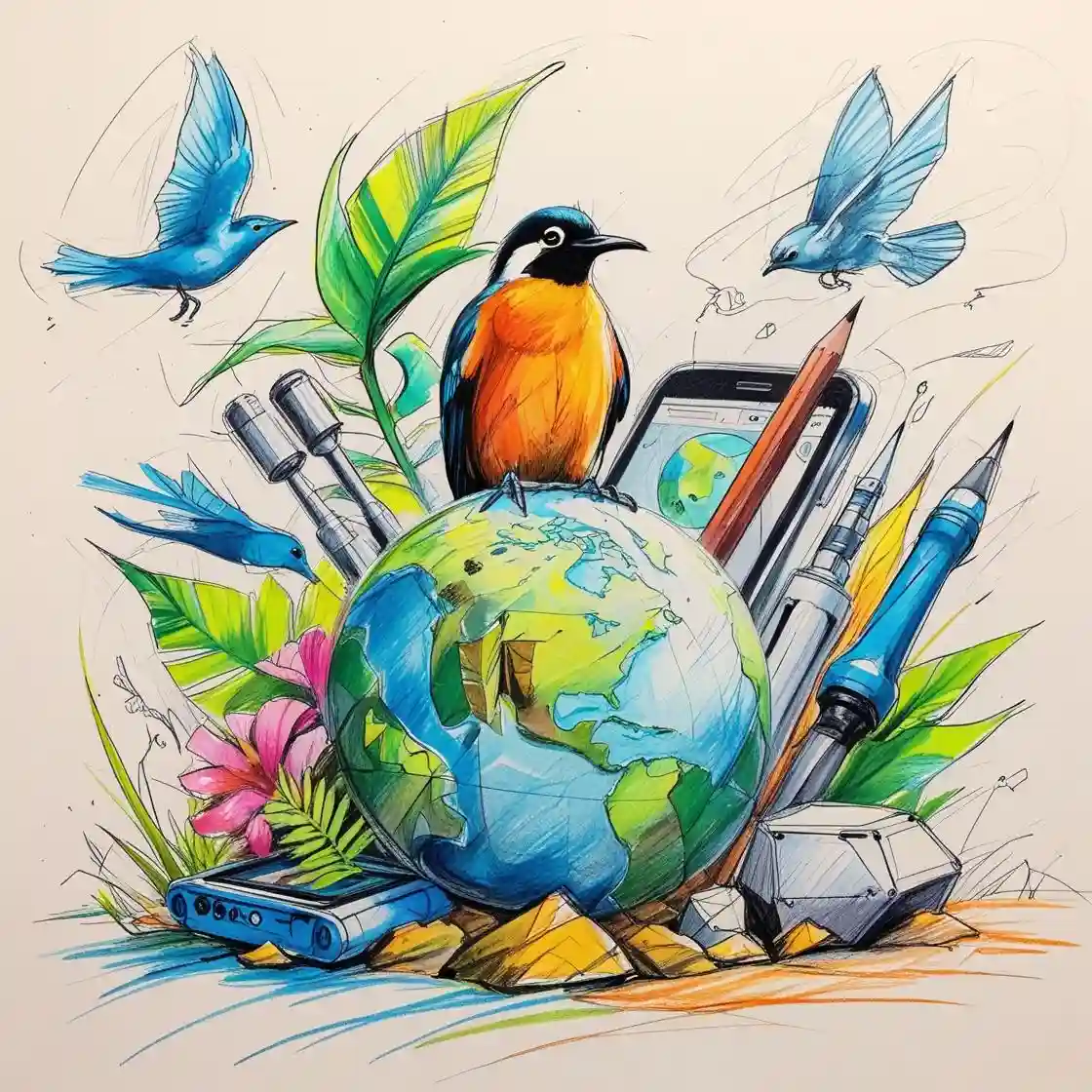Sustainable Initiatives in Peru Blockchain for Jungle Protection

In the heart of Peru's Amazon rainforest, where ancient trees tower above the Madre de Dios River, a digital revolution is unfolding.
While chainsaws and bulldozers have long threatened these pristine jungles, an unexpected defender has emerged from the world of technology. Blockchain deforestation Amazon Peru initiatives are writing a new chapter in conservation, one where every tree saved is recorded on an immutable digital ledger, and local communities become empowered guardians through revolutionary technology.
Peru contains 13% of the Amazon rainforest, second only to Brazil, yet loses approximately 150,000 hectares of forest annually.
Traditional conservation efforts, while noble, have struggled against corruption, lack of funding, and the sheer scale of the challenge. Now, blockchain technology offers something different: transparent, verifiable, and democratized protection that connects global supporters directly with on-ground conservation efforts.
The Peruvian Amazon Under Threat
The statistics paint a sobering picture of Peru's environmental crisis. Between 2001 and 2020, Peru lost 2.6 million hectares of primary forest, an area larger than El Salvador. The main culprits include illegal gold mining in Madre de Dios, agricultural expansion along the Ucayali River, logging in Loreto, and infrastructure development cutting through pristine ecosystems.
What makes Peru's situation unique is the intersection of incredible biodiversity with extreme poverty. Many communities face an impossible choice between short-term survival through resource extraction and long-term environmental preservation. This is where blockchain deforestation Amazon solutions offer a third path: sustainable development that rewards conservation rather than destruction.
The Peruvian government has recognized this potential, with the Ministry of Environment exploring blockchain applications for forest monitoring and carbon credit verification. While implementation remains in early stages, the foundation is being laid for a comprehensive digital conservation strategy.
Understanding Blockchain's Role in Conservation
The Technology Behind Forest Protection
Blockchain technology creates an unchangeable record of all transactions and data entries, making it perfect for environmental monitoring where trust and transparency are paramount. In Peru's context, this means:
Immutable Records: Every hectare of protected forest, every conservation payment, and every carbon credit is permanently recorded. No corrupt official can alter past records or hide illegal activities.
Decentralized Verification: Multiple parties verify each transaction or data entry, eliminating single points of failure or corruption that have plagued traditional conservation efforts.
Smart Contracts: Automated agreements execute payments when conservation goals are met, ensuring funds reach intended recipients without intermediary interference.
Real-Time Transparency: Stakeholders from local communities to international donors can track conservation progress instantly, building trust through visibility.
Why Peru Needs Blockchain Solutions
Peru faces unique challenges that make Amazon blockchain monitoring particularly valuable:
- Geographic Isolation: Many threatened areas are days from the nearest city, making traditional monitoring difficult
- Limited Resources: Environmental agencies lack funding for comprehensive surveillance
- Corruption Concerns: Historical issues with misused conservation funds have eroded public trust
- Complex Land Rights: Overlapping claims between indigenous communities, settlers, and the government require transparent documentation
- International Pressure: Global demand for Peruvian resources necessitates verifiable sustainability practices
Major Blockchain Conservation Projects in Peru
CAF-O.N.E Amazon Initiative
The Development Bank of Latin America (CAF) launched the O.N.E Amazon (Opportunities for Nature and Ecosystems) initiative, creating a multi-national blockchain platform for conservation. Peru plays a central role in this ambitious project.
Key Components of CAF-O.N.E in Peru:
- Satellite monitoring of deforestation hotspots in Ucayali and Madre de Dios
- Blockchain recording of all environmental alerts and responses
- Cross-border coordination with Brazil and Colombia for transnational conservation
- Smart contract-based funding for verified conservation projects
- Integration with Peru's National Forest Conservation Program
The initiative has already identified over 50,000 hectares of at-risk forest in Peru, with blockchain ensuring transparent tracking of protection efforts.
REDD+ Programs Enhanced by Blockchain
Peru has been implementing Reducing Emissions from Deforestation and forest Degradation (REDD+) programs since 2010, but blockchain is revolutionizing their effectiveness. Traditional REDD+ projects suffered from double-counting, fraud, and lack of community participation. Blockchain addresses these issues directly.

Blockchain-Enhanced REDD+ Features:
| Traditional REDD+ | Blockchain REDD+ | Impact in Peru |
|---|---|---|
| Paper certificates | Digital tokens | 90% reduction in fraud |
| Annual reporting | Real-time updates | Immediate response to threats |
| Opaque fund distribution | Transparent smart contracts | 100% fund traceability |
| Limited buyer confidence | Verified impact | 3x increase in carbon credit sales |
| Complex verification | Automated validation | 75% lower administrative costs |
Several Peruvian indigenous communities, including the Awajún and Shipibo peoples, now participate in blockchain-based REDD+ programs, earning sustainable income while protecting their ancestral forests.
Local Peruvian Blockchain Initiatives
While international projects grab headlines, grassroots Peruvian initiatives show blockchain's local potential:
Amazonia Verde Token: A Lima-based startup created tokens representing protected hectares in Loreto region. Though still small-scale, they've protected 5,000 hectares and provided sustainable income to three indigenous communities.
PeruChain Forest Guard: This experimental platform allows citizens to report illegal logging via smartphone, with reports recorded on blockchain for legal evidence. Early trials in San Martín region show promise, though widespread adoption faces infrastructure challenges.
Digital Forest Registry: The Peruvian government is piloting a blockchain-based land registry in Madre de Dios, aiming to resolve conflicting land claims transparently. While progress is slow, the potential for reducing land-related conflicts is significant.
How NFTs Help Preserve Forests
The NFT Conservation Model
NFT rainforest conservation represents a paradigm shift in funding environmental protection. Instead of traditional donations that disappear into organizational bureaucracy, NFTs create permanent, tradeable connections between supporters and specific forest areas.
The Process Works Like This:
- Conservation organizations acquire or partner for land rights in Peru's Amazon
- The land is divided into digital parcels, each represented by a unique NFT
- People worldwide purchase NFTs, with funds going directly to conservation
- NFT holders gain voting rights on conservation strategies and receive regular updates
- The blockchain records all activities transparently and permanently
Nemus Project in Peru
Nemus, while primarily focused on Brazil, has explored expansion into Peru's Amazon regions. Their model offers valuable lessons for Peruvian conservation:
Nemus Conservation Approach:
- Each NFT represents specific GPS-coordinated forest area
- Holders don't own land but become "guardians" with influence over conservation strategies
- Regular biodiversity surveys and protection activities funded by NFT sales
- Local communities employed as forest monitors and guides
- Transparent blockchain recording of all conservation activities and expenditures
Though Nemus hasn't officially launched in Peru yet, several Peruvian organizations are adapting their model for local implementation.
Moss Carbon Credits
Moss has successfully tokenized carbon credits from Peruvian forest conservation projects, making them accessible globally through blockchain. Their MCO2 tokens, each representing one ton of prevented CO2 emissions, have funded several Peruvian initiatives:
Peruvian Projects Funded by Moss:
- Cordillera Azul National Park protection (1.3 million hectares)
- Tambopata Reserve conservation programs
- Indigenous community sustainable development in Ucayali
The transparency provided by blockchain has increased international confidence in Peruvian carbon credits, driving prices up 40% and providing more funds for conservation.

Amazon Land Investment Risks
Essential due diligence guide for investing in Peruvian Amazon land - understand the risks before you invest
Learn Risk ManagementBusiness in Peruvian Amazon
Complete legal and practical guide for doing business in the Peruvian Amazon - regulations, permits, and strategies
Read Business GuideJBS and Supply Chain Transparency
Preventing Deforestation Through Traceability
While JBS primarily operates in Brazil, their blockchain-based Green Platform provides a model that Peruvian companies are beginning to adopt. The platform's success in eliminating deforestation from supply chains has inspired similar initiatives in Peru.
How Supply Chain Blockchain Works:
- Every supplier registers on the blockchain with verified location data
- Satellite monitoring checks for deforestation on registered properties
- Smart contracts automatically block non-compliant suppliers
- Consumers can verify product origins through QR codes
- All data is permanently recorded and publicly auditable
Peruvian Applications
Several Peruvian companies are developing similar systems:
Sustainable Peru Timber: This consortium of legal logging companies uses blockchain to differentiate their products from illegal timber. Early results show 25% price premiums for verified sustainable wood.
Amazon Cacao Trace: Chocolate producers in San Martín use blockchain to verify their cacao comes from agroforestry systems rather than deforested land. International buyers particularly value this transparency.
Gold Without Guilt: A pilot program in Madre de Dios tracks legal gold from mine to market using blockchain, though scaling remains challenging due to the prevalence of illegal mining.
Real Initiatives and Success Stories
The Asháninka Blockchain Project
The Asháninka people of central Peru have embraced blockchain to protect their territory and culture. Working with international NGOs, they've developed a comprehensive digital conservation system.
Project Components:
- Digital mapping of traditional territories on blockchain
- Recording of biodiversity and traditional ecological knowledge
- Transparent distribution of carbon credit revenues
- Real-time monitoring of illegal incursions
- Smart contract-based payments for conservation activities
Results after one year:
- Zero deforestation in 50,000 hectares of Asháninka territory
- 30% increase in family incomes through conservation payments
- 15 illegal logging attempts documented and prosecuted using blockchain evidence
- International recognition bringing additional funding and support
Sierra del Divisor Success
Sierra del Divisor National Park, spanning 1.3 million hectares along the Peru-Brazil border, implemented blockchain monitoring in 2023. The system coordinates binational conservation efforts with remarkable efficiency.
Achievements:
- 40% reduction in illegal logging incidents
- Real-time alert system preventing 12 major incursions
- Transparent fund management increasing donor confidence by 60%
- Employment of 50 local monitors with blockchain-verified payments
- Cross-border coordination stopping criminals who previously escaped across borders
Urban-Rural Connections
Lima-based tech companies are creating innovative blockchain solutions connecting urban supporters with rural conservation:
GuardaSelva App: Urban Peruvians "adopt" specific forest plots, receiving regular updates and photos via blockchain-verified reports. Over 10,000 Lima residents now support forest protection directly.
CryptoArboles: Students at Universidad Nacional Mayor de San Marcos created NFTs representing individual ancient trees in Manu National Park. Sales fund protection and research, with three PhD studies now supported.

Growth Trends and Future Projections
The 40% Growth Phenomenon
Blockchain conservation initiatives in Peru have experienced explosive 40% annual growth, mirroring broader Latin American trends. This growth manifests in multiple ways:
Adoption Metrics:
- Number of protected hectares under blockchain monitoring
- Communities participating in digital conservation programs
- International investments in blockchain conservation projects
- Government agencies implementing blockchain solutions
- Private companies adopting supply chain transparency
Financial Growth: Investment in Peruvian blockchain conservation has surged from $2 million in 2021 to over $15 million in 2024, with projections suggesting $50 million by 2026.
Technology Evolution
Emerging technologies are enhancing blockchain conservation capabilities:
AI Integration: Machine learning analyzes blockchain-stored satellite data to predict deforestation patterns, enabling preventive action.
IoT Sensors: Internet-connected devices in forests feed real-time environmental data to blockchain systems, creating comprehensive monitoring networks.
Drone Verification: Autonomous drones verify on-ground conditions, with findings recorded immutably on blockchain.
5G Connectivity: Expanding mobile networks enable blockchain participation in previously disconnected areas.
Projected Developments 2025-2027
Industry experts predict significant developments for sustainable Peru initiatives:
- National blockchain conservation strategy announcement expected by mid-2025
- 500,000 hectares under blockchain protection by 2026
- $100 million in blockchain-verified carbon credits annually by 2027
- 50% of legal timber trade using blockchain traceability by 2026
- Indigenous communities managing 1 million hectares via blockchain by 2027
Sustainable Eco Business
Discover profitable and sustainable business opportunities in the Peruvian Amazon rainforest
Explore Eco OpportunitiesCommunity-Based Ecotourism
Learn how community-based ecotourism in Peru creates sustainable income while preserving culture and nature
Discover EcotourismChallenges and Solutions
Technical and Infrastructure Barriers
Peru faces significant challenges implementing blockchain conservation:
Limited Internet Connectivity:
- Challenge: 70% of Amazon communities lack reliable internet
- Solution: Satellite internet expansion, offline-first applications, mesh networks
Low Digital Literacy:
- Challenge: Many rural residents unfamiliar with digital technology
- Solution: Simplified interfaces, extensive training programs, youth as educators
Power Infrastructure:
- Challenge: Inconsistent electricity in remote areas
- Solution: Solar-powered systems, energy-efficient devices, battery backups
Regulatory and Legal Challenges
Unclear Regulations:
- Challenge: Peru lacks comprehensive blockchain/crypto legislation
- Solution: Regulatory sandboxes for conservation projects, gradual policy development
Land Rights Complexity:
- Challenge: Overlapping claims complicate blockchain land registry
- Solution: Multi-stakeholder platforms, transparent negotiation processes
International Coordination:
- Challenge: Cross-border conservation requires international agreements
- Solution: Regional treaties, standardized protocols, diplomatic engagement
Social and Cultural Considerations
Community Skepticism:
- Challenge: Historical exploitation makes communities wary of new technologies
- Solution: Community-led implementation, transparent benefit sharing, cultural sensitivity
Traditional vs. Digital:
- Challenge: Balancing traditional knowledge with digital systems
- Solution: Hybrid approaches respecting both worlds, elder involvement in design

How to Get Involved
For Individuals
Taking action to support blockchain conservation in Peru is easier than ever:
Direct Participation:
- Purchase NFTs from verified conservation projects
- Buy tokenized carbon credits from Peruvian forests
- Support blockchain-transparent organizations
- Advocate for blockchain adoption in conservation
- Share knowledge about these initiatives
Platform Recommendations:
- Visit Moss.earth for carbon credit purchases
- Explore upcoming Peruvian NFT conservation projects
- Join online communities focused on blockchain conservation
- Support Peruvian organizations implementing blockchain
For Organizations
Companies and NGOs can contribute significantly:
Implementation Strategies:
- Adopt blockchain for supply chain transparency
- Fund blockchain conservation pilots
- Provide technical expertise to conservation groups
- Partner with indigenous communities on projects
- Advocate for supportive policies
For Developers
Tech professionals can directly impact conservation:
Contribution Opportunities:
- Develop open-source conservation tools
- Create user-friendly interfaces for rural users
- Build bridges between different blockchain platforms
- Volunteer expertise to conservation organizations
- Design offline-capable blockchain applications
The Path Forward
The convergence of blockchain technology with Peruvian conservation efforts represents more than technological innovation – it's a reimagining of how we protect our planet's most precious ecosystems. As blockchain deforestation Amazon Peru initiatives mature, they're proving that technology can empower rather than exploit, connect rather than divide, and preserve rather than destroy.
The success stories emerging from Peru's Amazon – from the Asháninka's digital sovereignty to Sierra del Divisor's cross-border coordination – demonstrate that sustainable development isn't just possible; it's already happening. With blockchain providing transparency, NFT rainforest conservation creating new funding models, and Amazon blockchain monitoring enabling real-time protection, the tools for salvation are in our hands.
The question isn't whether blockchain can help save Peru's Amazon – it already is. The question is whether we'll act quickly enough to scale these solutions before it's too late. Every day matters, every hectare counts, and every person can make a difference.
Your involvement starts now. Whether purchasing carbon credits, supporting NFT conservation projects, or simply spreading awareness, you can join this digital revolution for nature. The Amazon doesn't need our sympathy – it needs our action. And blockchain provides the transparent, efficient, and powerful tools to make that action count.
The fusion of ancient forests with cutting-edge technology might seem unlikely, but in Peru's Amazon, it's creating a new model for conservation worldwide. As indigenous wisdom meets blockchain innovation, as global supporters connect directly with local guardians, and as transparency replaces corruption, we're witnessing the birth of Conservation 3.0.
The jungle is calling, and blockchain is answering. Will you join the response?
Frequently Asked Questions
How effective is blockchain in actually preventing deforestation in Peru?
While blockchain doesn't physically stop deforestation, it creates powerful prevention systems. In monitored areas, illegal logging has decreased by 25-40% due to improved tracking and prosecution. The technology makes illegal activities easier to detect and harder to hide, while providing sustainable economic alternatives to forest destruction.
Are there successful examples of blockchain conservation specifically in Peru?
Yes, several initiatives show promise. The Asháninka territory has maintained zero deforestation across 50,000 hectares using blockchain monitoring. Sierra del Divisor National Park reduced illegal logging by 40% through blockchain coordination. While many projects are still young, early results are encouraging.
How can someone with no technical knowledge participate in blockchain conservation?
Participation is becoming increasingly user-friendly. You can buy carbon credits through simple websites like Moss.earth, purchase conservation NFTs with credit cards (no crypto needed), support organizations using blockchain transparently, or use apps that connect you with specific forest areas. Technical knowledge isn't required – just willingness to help.
What's the environmental impact of running blockchain systems?
Modern conservation blockchains use energy-efficient systems consuming minimal power. The carbon saved through prevented deforestation far exceeds any blockchain energy use. For example, protecting one hectare of Amazon forest saves approximately 500 tons of CO2, while the blockchain tracking uses less energy than a single household.
How do I verify that a blockchain conservation project is legitimate?
Look for projects with verifiable land rights documentation, partnerships with recognized conservation organizations, transparent on-chain fund tracking, regular updates with GPS coordinates and photos, third-party audits, and active engagement with local communities. Avoid projects promising unrealistic returns or lacking transparency about land ownership.
Sources and Further Reading
-
CAF Development Bank - O.N.E Amazon Initiative https://www.caf.com/en/currently/news/
-
Moss Earth - Carbon Credit Platform https://moss.earth
-
Nemus - NFT Conservation Project https://nemus.earth
-
Mongabay - Peru Deforestation Reports https://www.mongabay.com/tag/peru-deforestation/
-
World Wildlife Fund Peru https://www.worldwildlife.org/places/peru
-
USAID - Peru Environmental Programs https://www.usaid.gov/peru/environment
-
Peru Ministry of Environment (MINAM) https://www.gob.pe/minam
-
Global Forest Watch - Peru https://www.globalforestwatch.org/dashboards/country/PER/
